In theory, marketing healthcare should be easy. After all, it’s something that everyone knows they need – whether it’s hospital treatment for an urgent condition, residential care for a loved one or sex therapy and education (ok, maybe that one’s a harder sell!).
But in reality, communicating what you do as a healthcare organisation can be as delicate and as challenging as a triple bypass.
You need to find the right way to promote the brilliance of what you do without promising benefits you can’t guarantee. You need to strike the right balance between your various audiences and stakeholders.
And above all, you need to help your audience find peace of mind that they’re putting their trust in the right team of experts.
TL:DR
- Challenge 01: Compliance
- Challenge 02: Diverse stakeholders
- Challenge 03: Trust
- Getting healthcare comms right
Challenge 01: Compliance
When you put out any kind of healthcare marketing and content, the first challenge is always making sure it’s accurate and compliant. You’re not advising people on when to belt a swing dress or the right order to watch the Marvel movies – you’re helping them make decisions about their health and wellbeing.
That means whatever claims you make about your products or services are going to be scrutinised more than most, starting with the various regulations and codes of practice that govern healthcare marketing.
In the UK, for example, the Advertising Standards Authority (ASA) and Committee of Advertising Practice (CAP) have specific codes governing what claims you can make depending on what kind of medicine, treatment or device you’re marketing.
And the ASA is just one of many threads. Its codes on healthcare advertising are also supported by the Blue Guide from the Medicines and Healthcare products Regulatory Agency (MHRA), an agency of the Department of Health and Social Care. Then there’s the European Federation of Pharmaceutical Industry Associations (EFPIA) Code of Practice, which exists to hold up integrity and ethical practice in medical communications.
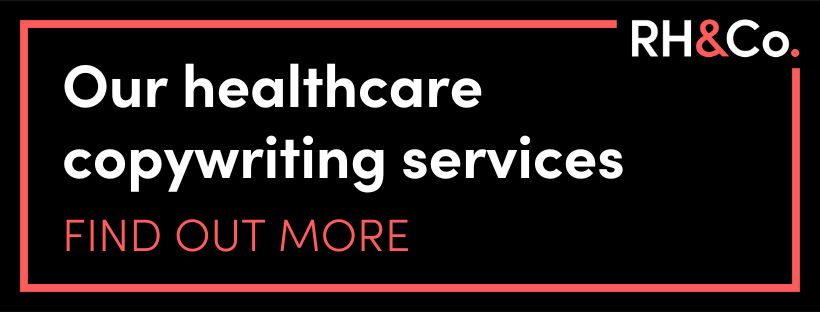
SEO for healthcare brands
Even if there wasn’t this tight regulatory lattice to navigate, there’s still the matter of SEO to consider. Sites like Google don’t particularly want to come under fire if users come to harm as a result of something they found in the search results, and so they set higher standards for pages covering healthcare topics.
In Google’s case, it’s about YMYL – ie Your Money or Your Life. YMYL is a phrase Google uses to identify pages that can have a significant impact on a reader’s health, happiness and safety. If they categorise a page as YMYL content, you have to work harder to prove that content is based on verifiable facts – and avoid overselling any unproven benefits – if you want it to rank.
We worked with a probiotic brand who faced this exact challenge. They weren’t able to make certain claims about their products because parts of the certification process were still ongoing. It didn’t matter that they were confident those benefits were there thanks to their own rigorous scientific testing – until the relevant body had approved it, it couldn’t be written down.
That shifted the marketing focus onto what we did know for certain – the results that could be proven with lab study figures. Potential customers were then able to draw their own conclusions about whether the probiotics would be beneficial for them, without the risk of them being misinformed.
Challenge 02: Diverse stakeholders
After compliance, the next challenge is knowing who you’re speaking to. With healthcare, you’re rarely talking to just one audience group at a time. Patients, practitioners, regulators, investors, researchers – your campaigns and content often have to speak to multiple groups of people, sometimes at the same time. Finding the right way to land your message requires a clear strategy.
The distinctions between audiences can be incredibly subtle, as we found when writing for a regional luxury care home client a few years ago. On the one hand, their campaign needed to speak to the elderly people who might become residents at the care home, showing what that life could look like for them.
But it also needed to address those residents’ children or other family members, who are often key decision makers when it comes to care home selection. They needed a slightly different set of questions answered – chiefly, “How will my loved one be looked after here?” and “Will they be OK?”
Other times, you might be serving a much broader spectrum of audiences, all with their own segmented needs and levels of understanding. When we worked with Health Innovation Network (formerly the AHSN Network), the innovation arm of the NHS, one of their key challenges was that their website needed to be a resource for everyone from patients and healthcare workers, to researchers and innovators.
Trying to find a way to speak to everyone at once would end up with content that didn’t really answer anyone’s needs. Instead, we advised them on the UX of their website and laid out their different audience groups clearly at the top of the home page, so that site users could go directly to the content and advice tailored to them.
Challenge 03: Trust
Lastly, we come to the challenge of trust. Trust is arguably the most important challenge on this list. Not just because you’re asking patients and customers to trust you with their wellbeing, but because the other challenges of navigating compliance and the diverse needs of your audiences feed into it as well.
But trust doesn’t only come down to getting those factors right. There are also the foundational elements that every brand, healthcare or otherwise, has to nail – consistent brand tone of voice and messaging.
Finding that consistency can be difficult in the healthcare industry. You might have some content that uses the common terms for conditions or symptoms (like “blood poisoning” or “fits”) and other content using medical terms (like “sepsis” or “seizures”). One campaign might refer to “patients” while another speaks about “residents”. If you’re a large organisation or network, you’ve also got the challenge of keeping consistency across multiple departments.
Also bear in mind that in healthcare, consistency in communication doesn’t just mean what’s written down – it’s about how everyone in your organisation talks about what you do. Take our previous care home client as an example again.
Imagine somebody reading through the care home brochures and website to find care for their loved one. But while the written copy talks about the care home’s “residents”, everyone they speak to on a visit says “patients” instead. It might seem like a small detail, but it’s enough to suggest a split between how the organisation wants to be seen and how it actually operates.

Getting healthcare comms right
Getting healthcare comms right starts where all good comms should – at the strategy stage. More than in any other sector, with such a big emphasis on transparency and trust, you need to truly understand your own brand (your value proposition, differentiators, limitations and so on) as well as your various audiences and your competitive landscape.
From there, it’s about creating brand voice and messaging guidelines that empower internal teams and external suppliers such as marketing agencies to be consistent throughout all of your comms, in any format and on any channel. And having a robust content strategy that allows you to build that brand messaging into a solid and lasting reputation that engenders the kind of trust you need to win your audience over.
At RH&Co, we’ve worked with healthcare brands from a small pharma startup to an international hospital group, from a healthtech app to a luxury care home group. If you need support with clarifying and communicating your message or building your brand reputation and authority, get in touch today.
Remember when you were a kid and a letter arrived in the post, addressed to you? It was so exciting! Then you grew up and started getting lots of post and it quickly became less exciting because a) it wasn’t so novel anymore and b) it was mostly bills or flyers for things you didn’t want.
That’s exactly what’s happened in the world of content marketing since it first took off in the early 2000s.
At first, it was great to be able to read helpful articles and watch cool videos and listen to interesting podcasts. We could learn about how to overcome challenges at work and in life. We could stay up to date with the latest trends and get insights and opinions from influencers and experts.
But now there’s just so much content out there and most of it is rubbish, which is making us increasingly cynical about how valuable it actually is. And this noise and cynicism is only being made worse by AI.
So, does that mean content is dead? Of course not. Content can deliver enormous benefits for businesses, especially those looking to establish themselves as experts in their field. It just needs a far more strategic approach these days.
TLDR:
- Pillar 01: Resonance – creating content your audience will actually want to read
- Pillar 02: Reach – ensuring your content gets in front of the right eyes at the right time
- Pillar 03: Results – making a plan that connects your content to a bottom line result
- Bonus pillar: Repurposing – squeezing every last drop of value from your content
Pillar 01: Resonance – creating content your audience will actually want to read
The most common problem we see with content creation today is an incredibly simple one: brands creating content they want to create, rather than content their audience is actually interested in.
Like the SaaS brands that stuff blog posts full of detail about their features but don’t tie that detail to their customers’ challenges so they feel like adverts rather than valuable, educational content.
Ensuring that your content resonates with your audience starts with audience research. Your best bet is talking directly to them and asking them what they’re interested in. Customer interviews, focus groups, surveys and polls can all give you valuable primary insights.
Content tends to take a minimum of 6 months to start showing results, and often more like 12-18 months in terms of bottomline ROI.
There’s also secondary research you can do. What are the trending topics in your industry? Look at industry press and key influencers – what are they talking about? Social media is another place to dig. Pick a number of key personal accounts – current customers or clients, or people you’d like to work with – and see what they’re posting about or engaging with.
This isn’t about jumping on bandwagons, it’s about understanding what people care about. The goal is to take what you’ve learned about your audience’s interests and overlay that with your own knowledge, expertise and strategic business goals – be that “be seen as an authority on wearable healthtech” or “expand our reach into the US market”. In doing so you create a Venn diagram, the centre of which is your sweet spot for content creation.
The final ‘Resonance’ question to answer is what format will your content take. Does your audience prefer written, visual or audio content? Long form or short form? Digital or in-person? Chances are your content will span several options but you’ll most likely major on one, especially if you have a smaller budget.
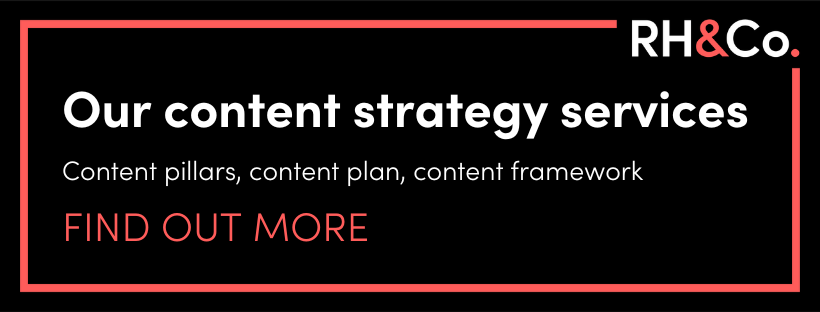
Pillar 02: Reach – ensuring your content gets in front of the right eyes at the right time
Having established the topic pillars your content should be created around, and the format most likely to resonate, you need to consider how you’re going to get eyes on that content.
What channels are you going to use to find your audience? You could take an inbound approach, creating articles and videos, hosting webinars, sharing posts on social media, and letting your audience come to you. You can also optimise your content and get visits through organic SEO.
Or you could be more proactive, and use advertising, email outreach, industry events. You could work with your sales team to create an ABM campaign that targets a list of individuals and companies that you want to build relationships with and send out relevant content depending on their specific needs.
Again, a combination of both is likely to be most effective, and different channels will suit different stages of the buyer journey. SEO is particularly effective for middle of funnel content where buyers are in research mode, whereas thought leadership is great for social media, webinars, conference speaking or as a way to follow up with a lead.
Whatever you decide, plan to give the strategy enough time to be effective. Content tends to take a minimum of 6 months to start showing results, and often more like 12-18 months in terms of bottomline ROI.

Pillar 03: Results – making a plan that connects your content to a bottom line result
While much of content marketing is about brand building, all marketing should be designed to eventually deliver qualified leads that are more likely to convert into sales. But that doesn’t mean you have to stick a “buy now” or “book a demo” CTA on every piece of content.
Content marketing is a long game, and it’s about building relationships. That means that rather than sell, sell, sell, your goal should be to move people forward in some way or another, towards a sale at some point in the future.
For example, if someone reads a top of funnel blog post, you might want them to read a middle of funnel post next, or sign up for a newsletter or a webinar. If they’ve downloaded a piece of gated content, you’ll need to have a nurture sequence ready, which might end with a “book a free consultation” CTA.
We recently helped a client in the employee recognition software space to do just this. First, we created a top of funnel blog about why data insights on workplace culture are useless if managers have no way to act on them.
The CTA and overall narrative led to the middle of funnel content, which was a gated playbook on what strategies HR can take to give managers more power and autonomy in recognising employee contributions, and how tech can help facilitate that. That last tech section then fed into the bottom of funnel blog on their software and how it’s built to empower managers rather than just give data insights to HR and the C-suite.
Ideally, you want every step in the buyer journey to be mapped out, and to know what the next desired action is for each piece of content you share, so that you can guide them accordingly and set meaningful metrics for success.
Bonus pillar: Repurposing – squeezing every last drop of value from your content
At this stage you should have a pretty good strategy for how to create content that resonates with your target audience, that reaches the right people at the right time, and that ultimately drives bottom line results.
Most likely, you’ll be using several different types of content and different channels at different stages of the buyer journey – which may leave you feeling overwhelmed by how much you need to produce.
But if you’re clever, you can ensure that the bulk of the work happens in one or two areas. After that, it’s about repurposing as much as you possibly can.
For example, you might commission a piece of research and create a white paper with input from your internal subject matter experts. This will take time, effort and budget. But you won’t just be left with one piece of content.
You’ll have core messaging themes on which you can build an entire campaign.
You’ll have quotes, stats and other snippets that you can use on social media, in emails, even in person.
You’ll have themes you can develop in further blog posts, and tie to your case studies.
And you’ll have findings your subject matter experts can discuss on podcasts, at events or in the press.
The harder you can make your content work for you, the more chance you’ll have of getting the right eyes on it. They might miss your white paper launch, but they’ll see its insights later in the week in social media snippets. Or perhaps they won’t have time to read a whole download, but will pop on a podcast to hear your SMEs talk it over.
This is why it’s important not to scrimp on content strategy and rush straight to the deliverables. Investing in the thinking up front means saving on wasted efforts down the line and gives you a far better chance of getting the results you want.
If you want to get your content working harder for you, get in touch to find out how we can support you with content strategy, campaign design and content creation services.
A few weeks ago, we attended a marketing conference in Bristol. We made it roughly eight minutes into the initial coffee-and-hello part of the event before someone asked us The Question: “So, how much is AI impacting what you do?”
We get it; everyone wants to talk about ChatGPT and the ramifications for writers these days. Us included – barely a day goes by without at least one conversation about AI, from the ethical questions around its use to how it will make it more difficult to cut through noise and cynicism.
Having seen generative AI at work, we’ve always been pretty confident that it won’t be replacing great human writers any time soon. But while it might not be up to crafting an expert-led article or inventive web copy by itself, we didn’t want to write it off entirely without giving it a good faith go at showing what else it’s capable of.
So for the last few months, I’ve been experimenting with adding AI into the work we do – not having it produce content for clients but asking what other parts of the creative process it could help make more efficient.
ChatGPT doesn’t have a creative bone in its binary code
Getting past the blank page
One of the first experiments I tried with ChatGPT was seeing if it could speed up the process of creating a blog outline. Not write a blog by itself – just to take our notes from a briefing or the transcript of a client call and order the key points into a skeleton we can then write from.
The results were mixed at best but let’s start with the positives. I was surprised at how well ChatGPT could identify the key points of a conversation from only a video call transcript and not only list them out but also provide bullet point summaries of what a client had said around each point.
But when it came to threading those points together into a blog outline, the limitations hit hard. For one, ChatGPT doesn’t have a creative bone in its binary code, so it couldn’t identify any narrative behind the key points it had picked out. It could only create an outline that followed the same course as the conversation, from one point to the next, neatly tucked between a school essay-style intro and conclusion.
It also struggled with the idea that each key point doesn’t need to be a separate section. If given little instruction, it would simply turn each element of the conversation into its own subhead. The result would be a dozen or more sections, plus intro and outro – way too many to squeeze into a +/- 1,000-word article.
If I got more detailed in my prompts, specifying 3-4 subheadings and asking it to group certain key points together to make one blog section, it would get confused. Sometimes it cut down its previous attempt to four subheads by cutting off the bottom eight rather than grouping things together. Other times it just hallucinated and returned any random number of subheads with an apology after for not being able to count to four.
To structure an article, you have to be able to discern – not just what was said in a briefing call but which points are most relevant to the topic at hand, and what narrative thread links them together in the way that’s most interesting to the person reading. And as it stands, that’s just not in ChatGPT’s wheelhouse right now.
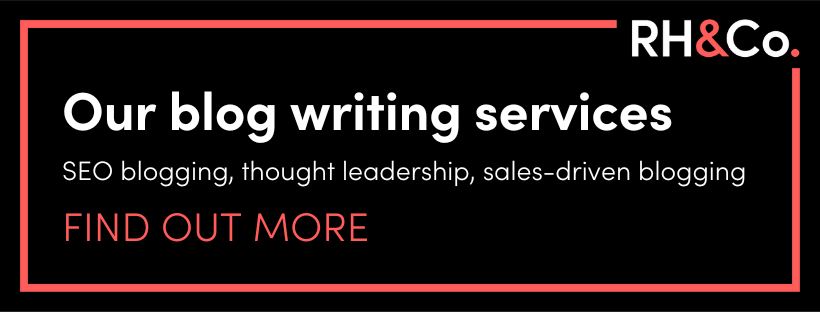
The world’s most eager research assistant
Given that one of ChatGPT’s primary goals is to help people find information fast, I was curious how well it would function as a research assistant. Researching can sometimes be the longest part of writing an article. You know the right statistic is out there but finding it on a site that isn’t disreputable, out of date or, worse, a client’s competitor can be a slog. So any way that AI could speed that up would be a huge win.
There are two obvious problems to work around here:
- Hallucinations. The hardest thing ChatGPT can do is say it doesn’t have an answer, which means if it can’t find the stats you’re asking for, there’s a good chance it will make up results instead. You can ask ChatGPT to provide sources for its answers, but that doesn’t stop it from creating false stats – it just makes it quicker to fact check them.
- Recency. ChatGPT’s training data has a cutoff date, meaning anything published online after that isn’t in its knowledge banks. If you’re looking for anything from the last year (at time of writing, the free version powered by GPT-3.5 is only aware of events up to January 2022), ChatGPT simply cannot help.
But there was one other problem I didn’t expect to find when using ChatGPT to help with research. When it comes to research to support blogs, we’re not just looking for stats that back up what we want to write – we’re also looking for details we hadn’t considered before that spark new ideas and enrich the content.
For example, I was recently writing a blog about the importance of translation and localisation in the adoption of new tech products. When ChatGPT couldn’t return any relevant stats showing that localising marketing materials or UI does lead to greater adoption, I went searching myself. And while I didn’t find the stats I was looking for, I did find ones breaking down the proportions of non-English speakers in predominantly English-speaking countries.
It wasn’t the information I was originally looking for but it did lead me to a worthy point about the need for multilingual marketing even if you’re not planning to sell your products outside of one market – for example, Spanish in the US or French in Canada. But because ChatGPT is designed only to reply to the prompts you give it, it would never have been able to join the dots like this and suggest an angle I hadn’t yet considered.
Optimising articles for SEO
So when it comes to outlining blogs and sparking ideas, ChatGPT isn’t the best. But what about when an article is already written and just needs to be garnished with SEO keywords?
I figured this would be a simple experiment. I give ChatGPT the text of the article and a list of the necessary keywords, ask it to pepper them throughout the blog at least once each, and see what it does. SEO optimisation isn’t a particularly time consuming task, but any way AI could speed that up would be helpful.
Or so I thought.
On its first attempt, ChatGPT returned the exact text of the blog I’d pasted into my prompt. No alterations, no keywords, nothing. Just a word-for-word replica, and the proud assertion that it was a revised version.
After I pointed out what had gone wrong the first time, ChatGPT tried again. And to its credit, it did at least include most of the keywords this time – although they were all added on to the end of random paragraphs and with no accompanying sentence or context. Just… keyword.
I wondered if my prompt was the problem. I’d originally asked ChatGPT to add these words with minimal alteration to the blog itself, so for the third attempt I specified that it could make changes to the body text, such as adding new sentences in the middle of paragraphs, in order to insert the keywords. Just to be on the safe side, I also explicitly asked it to insert the keywords into paragraphs and not tack them onto the end as it had done before.
Third time’s the charm, right? Except… not quite. My attempts to cover off any loopholes or confusion in my prompt just led to ChatGPT returning the exact same copy as it had in its second response. The same keywords in the same places as before. I gave up and did it myself.
My theory on why this went so wrong comes back to the fact that ChatGPT can’t discern like humans can. Inserting SEO keywords might look like a simple find-and-replace job, but there’s more to it than that. To weave in terms without them feeling intrusive to the reader, you have to be able to look at the wider context of a paragraph or whole section. You have to understand which phrases are relevant to which key points in the article.
In other words, you have to use judgement and a little creative thinking – and as we’ve already established, neither of those are qualities ChatGPT can boast.

So… was using AI ever any quicker?
As I’ve been experimenting with AI, there’s one question that keeps coming to mind. It’s not “Is ChatGPT good enough to do X, Y or Z for me?” Instead, it’s “Am I just using AI for the sake of using AI?”
Let’s go back to blog outlines for an example. While ChatGPT falls short when it comes to narrative structures, there are some other kinds of content where AI can actually help. When we’re writing longer form pieces with a focus on SEO, it can help to have ChatGPT lay out distinct talking points in a linear fashion. And because it creates its responses from scraping its banks of training data, the subheads it suggests are usually pretty SEO-friendly.
But structuring a pillar page or a longform SEO piece is rarely something that needs speeding up. Unless you’re writing about a topic that has genuinely never been covered before, it’s pretty evident what information readers need to see and how you need to order it.
So does AI actually make this process any faster? Not really, no – or at least not enough for us to change our entire workflow and become part-time prompt engineers.
We’re all asking questions about AI at the moment – is it good enough, is it ethical, is it the thin end of the robot apocalypse wedge? Often those questions feel like they’re way too big for an individual to answer.
But there’s one question we should all be able to answer, AI expert or not – is using AI for this task worth it? Are ChatGPT, Bard, Dall-e and the like helping you to do something faster, to free up time you can better use elsewhere? Or are you just using them because they’re shiny, they’re new and they’re available?
Because if artificial intelligence can’t help us be any more effective or efficient where we need to be, we might be better off sticking with the intelligence we already have.
RH&Co founder, Rin Hamburgh, recently hosted an ‘Ask me anything’ webinar, answering your questions on all things B2B content strategy and planning for 2024. If you didn’t see it live, you can watch the video recording or, if you prefer your content in written format, have a look at the Q&A answer summaries below.
TL:DR
- What content should I prioritise if I have limited resources?
- What types of content are best outsourced vs done in-house?
- What’s the best way to measure how effective content is?
- Where should you publish blogs or articles – on your website or on a platform like LinkedIn, or Substack or Medium?
- What is the most common mistake you see people make with blogging (or content generally)?
- I’m struggling to get our technical experts involved in creating the content – do you‘ve any tips?
- Are case studies still useful content for B2B businesses, and if so, what format should they take?
- We have a big bank of podcast content – can we turn it into a blog series, and if so, how?
- What kind of content should you be sharing in a newsletter?
What content should I prioritise if I have limited resources?
Deciding what content to produce all starts with your business goals. Different types of content (and the different channels through which you can share them) are effective in different ways. So it’s important to understand what you’re looking to achieve – whether that’s scaling brand awareness, breaking into a new market, or increasing SQL conversions – so you can focus on the most appropriate content and channels.
You also need to understand what resources different types of content will require. For example, running paid ads requires a financial commitment over an extended period of time. On the other hand, posting regularly on LinkedIn takes time (and skill) but doesn’t necessarily have to cost anything.
In terms of putting all of this together into a strategy, think about your content priorities and frequency in terms of what LinkedIn’s Purna Virji calls ‘hum, sing and shout’ content:
- Hum: some lower level content to create consistency and maintain brand awareness over the long term.
- Sing: periodic small campaigns designed to achieve specific goals such as educating your audience on a key topic or going after a specific industry vertical.
- Shout: occasional hero content campaigns to support an important business objective such as a new product launch.
If you’re really pushed on resources and have to put all your eggs in one basket for the short term, think about where you can get the biggest wins most quickly. Do you have a large client database you could reach out to with a reintroduction or referral email campaign? Have you recently completed a prestigious project that you could use to create a case study or enter an award?
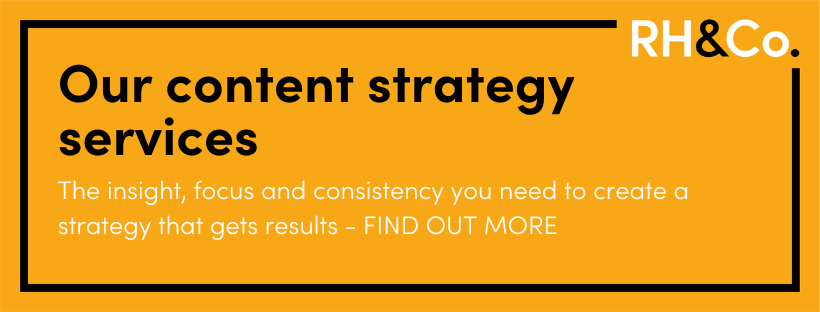
What types of content are best outsourced vs done in-house?
Naturally the biggest part of the decision about what content to outsource vs produce in-house is going to be what skills you and your team have. While many marketers have some practical delivery skills such as writing or design or videography, it’s likely you won’t be able to do all of them to the same standard as a specialist.
This might not be a problem. You’ll need to think about the standard required for your content. For example, if you’re filming an important explainer video, you might want a professional videographer involved. But if, like us, you’re doing a webinar Q&A, you can probably use the software on your laptop to film and edit it together on a shoestring.
What many of our clients do is engage us to create the larger, more complex pieces of content such as white papers or thought leadership articles, and then do the repurposing of that copy in-house to create social media content. In a similar way, you would need to get a design or branding agency involved in creating your visual branding in the first place, but could then go on to use that branding yourself to create ongoing design assets in-house.
What’s the best way to measure how effective content is?
Measuring content effectiveness starts with setting goals and then defining what metrics make most sense for that goal. Each type of content and each goal will have different metrics that you might want to track, so there’s no one best way. However, it’s important to think about two key things…
First, be specific. If you’re sharing thought leadership content on LinkedIn, don’t just look at how many impressions or engagements you’re getting. Think about whether you want those impressions and engagements to come from people in a particular industry sector or at a particular level of seniority, and track that.
Also, make sure your metrics are relevant. Taking the thought leadership example again, the likely goal for this is brand awareness. So measuring leads generated is probably a bit of a stretch. But if members of your expert or senior leadership team are invited to do a speaking engagement or be a guest on a podcast, that could be considered a relevant win.
Where should I publish blogs or articles – on our website or on a platform like LinkedIn, or Substack or Medium?
There are advantages and disadvantages to posting blogs or articles on a business website vs a social media platform like LinkedIn or a publishing platform like Substack or Medium.
One key issue is ownership. You own your website and therefore have control over it. Whereas on Substack, for example, the platform might disappear tomorrow, or it may require you to pay money in the form of promotions in order to get your articles in front of more people.
Posting to your website is also a way to attract people to that site, whether through SEO or organic social posting, where they can be exposed to more of your brand, products or services.
That said, not everyone is going to be willing to invest the time to click through to a post on your site – which psychologically feels like more of a commitment – whereas you might hold their attention for that bit longer if they can read within the platform they’re already on.
Ultimately your choice should be linked to your goals. If that goal is to raise your profile and grow your network within a given community, posting your content within that community can be very powerful. If, however, you want to drive traffic to your site and get people exploring your offering further, you might be better off posting the articles to your site and then sharing smaller snippets on social media.
This two pronged approach offers the best of both worlds, giving the browsers a taste of your brand and messaging while still allowing you to reap the benefits of hosting the larger content on your own site.
What is the most common mistake you see people make with blogging (or content generally)?
The biggest mistake we see people making with content is not thinking strategically enough about it. Often this shows up as writing about what they want to write about rather than considering what their audience wants to read about.
Another common issue is being too sales focused at the wrong time. You can’t write a top-of-funnel thought leadership piece and then follow up with a sales CTA like ‘book a demo’. It’s important to see content as a way of moving people along the customer journey, step by step.
A third mistake is giving up before they’ve invested enough time in content as a tactic. Content marketing can take time to build momentum – online marketing guru Neil Patel says you need to give it at least 6 to 9 months, while Joe Pulizzi, author of Content Inc, writes that it’s more like 12 to 18 months. It’s also not always easy to see the results on the bottom line, especially when it comes to brand building content, so make sure you set realistic and relevant goals that you can track your progress against.
I’m struggling to get our technical experts involved in creating the content – do you have any tips?
Getting subject matter experts involved in content creation can be difficult because they’re usually very busy and often feel they have better things to do. If they’re not sold on the idea of content, or marketing in general, you’ll need to start by making the case for why it’s important.
When they do get involved, make sure you’re not taking more of their time than you have to. Do your research and use whatever time they have available to get the information from them that only they can provide – the anecdotes, experiences and insights that are so important for expertise-based content.
We have a lot more tips on this subject in our blog post, ‘Involving experts in content creation: a guide for marketers’.
Are case studies still useful content for B2B businesses, and if so, what format should they take?
Absolutely. Case studies can be a very powerful tool for B2B marketers and sales people – particularly those in service businesses. They’re a way of demonstrating the value you offer in a real world context, and this is especially useful when your offering is complex or intangible.
Like testimonials, case studies let your customers talk on your behalf. If you say your product or services are effective, that’s one thing. If someone else says it, that’s much more impactful.
Also because human beings love stories, case studies are that much more engaging to read than a process document.
In terms of format, there are four key elements you need to include:
- A summary of who the client or customer is – their industry, size, business model, anything that will help your ideal target to see you’re a good fit for them too.
- The problem they were facing when they came to you. You might also want to describe what the real underlying problem turned out to be after your diagnosis.
- What you did to support the client in overcoming that challenge. Paint a picture of what it was like to buy from or work with you.
- The results you delivered. Sometimes these will be tangible and quantifiable, such as money saved or revenue increased, but your outcomes might not be so measurable. In that case you’ll need to include qualitative elements such as quotes from the client.
A final point: if your case studies are long, it can be helpful to include a summary of key points at the top of the page.
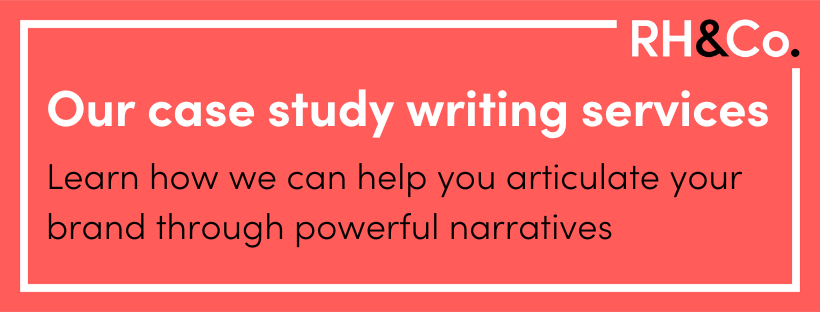
We have a big bank of podcast content – can we turn it into a blog series, and if so, how?
Repurposing content by translating it into a different format is a great way to maximise your return on investment. You can absolutely turn a podcast into a blog, with a different approach depending on what type of podcast it is.
For a host plus guest podcast: Usually these podcasts follow a Q&A format, which translates perfectly into the written form. Depending on the length of the podcast and the guest’s answers, it’s likely you’ll need to edit both questions and answers, making them more concise and suitable for a reading audience, rather than a listening one.
For a panel podcast: This is where you have several people all chatting about a particular subject. In this case, the subject matter is front and centre, so think about writing a blog post that addresses the topic, and use pulled quotes from the podcast to highlight key points. This sort of blog post will feel a lot like a newspaper or magazine article.
Using the full transcript: You can also publish the full transcript of the podcast. This doesn’t make it a blog post, but it can be helpful for those who have listened and want to go back to a certain point by searching for a keyword. It’s also super low effort – just get an AI translation tool and then go through to edit out the ‘ums’ and mistakes.
What kind of content should I be sharing in our company newsletter?
Newsletters are usually sent on a regular basis to a database of readers who have signed up to receive them, and the content tends to be informational, inspirational or otherwise valuable in some way, rather than overtly salesy.
In general, newsletters tend to fall into two main categories…
The first is the long form newsletter. This could include the whole text of a blog post, for example, so that those who are subscribed never miss a post. Or it could be a letter format written to the readership – essentially an article but with a more intimate feel, since it’s written for and to the members of a specific group.
The advantage of this sort of newsletter is that your reader doesn’t need to click through to a different location in order to read all of your content. All you have to do is convince them to open the email and start reading, and then keep them engaged.
The second type of newsletter is the roundup. This is where you have several different sections, each of which has a small amount of text and most likely a link or CTA button leading to more.
This is a great way to share on more than one topic without the newsletter becoming unwieldy. Your reader will feel that they can browse and choose just the items that interest them, clicking through if they are interested in finding out more. It can also be useful for personalising future content, using clicks as an indicator of interest.
Here’s what we include in the RH&Co’s The Right Words:
- Introduction – a chance to say hi and set out what’s in the rest of the newsletter
- Two blog posts – usually our most recent plus a popular one from the archives
- Word of the week – A favourite unusual word and its definition (this is a reader favourite!)
- Industry news – something we’ve read or watched that we think our readers will find helpful or interesting
- Our news – something we want to share, whether it’s an upcoming webinar or a new ebook
- Social link – A call to follow us on LinkedIn and see more of our content more regularly
Have you got a question?
Get in touch and let us know. We’ll be sure to update this article with relevant questions as often as we can!
Translating content into other languages has never been easier. You don’t even need a human translator. From Google Translate to Alexa, there are dozens of AI-powered tools promising to produce versions of your marketing and sales materials for consumption in any country you choose.
Except the reality is that if you give a piece of AI-translated content to a native speaker, you’ll soon find that there are problems. And not just with the language itself – the nuances, the colloquialisms, the most up-to-date expressions – but with what different cultures want and expect from that content.
We’ve been speaking to Anja Jones, founder and MD of fellow B Corp agency, AJT, about the importance of localisation and the benefits it offers to international businesses, from reaching new audiences and building brand trust to improving SEO and website conversions.
How would you define localisation?
Localisation, as the word suggests, is about adapting to a local market. Localisation goes way beyond translation in that it looks at the entire user/customer experience.
The aim of localisation is to build trust in prospective and existing clients. Trust is built more easily when things feel familiar. Just imagine yourself visiting a website from a company that’s based abroad. Being able to browse the website in English is already a huge help in accessing information – perhaps reading about a product and how it works, or understanding how the shipping works.
But beyond language, there are other things that might influence our buying decisions. The way a website is designed – is it laid out in a way that we’re familiar with? In Western Europe, websites tend to be ‘clean’ and minimalistic with plenty of white space, carefully placed images and small amounts of text. Compare that to websites in Asia, which are typically rather busy, densely packed with images and text.
Next, does the website offer payment methods that I’m familiar with? When you shop on a German website for example, you might find payment options British online shoppers are not really familiar with, such as SEPA Direct Debit and buying on invoice.
I believe we always need to come back to the purpose of the content we create, and what impact it needs to have on the reader, whether in the home market or abroad.
When it comes to written content, localisation is about adapting the translation to make it really relevant to the reader in the local market. This could be obvious things like converting currency and pricing from pound sterling to EUR; swapping out links so they lead to the localised version of your website, or swapping out external links (e.g. if referencing a study or particular piece of research) to make sure they’re really relevant to the local reader.
Localisation also means identifying which pieces of written content will be relevant and useful in a local market, and which ones don’t need to be localised at all. Instead of translating your entire library of blog articles, for example, it’s worth analysing which content pieces will be relevant in the local market. This involves carrying out multilingual keyword research to determine if there is any search volume for a particular topic before pushing the button on translation.
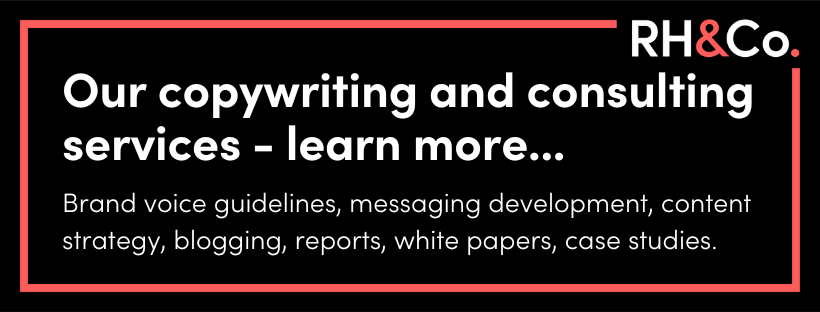
Wouldn’t it just be easier to write more internationally focused content that doesn’t need localisation?
Some say that when you create content that will be translated for an international audience, you should approach the content creation differently from the off. For example, you could use less hyper local references to make the translation process easier and faster.
On the flipside, others argue that professional translators are of course able to adapt cultural references and warn against watering down content to make it more easily palatable to everyone.
I can empathise with both sides of the argument but I believe we always need to come back to the purpose of the content we create, and what impact it needs to have on the reader, whether in the home market or abroad.
Localisation ensures that the content really lands well and has the desired impact. So the important thing is to be aware of cultural nuances and either build language capabilities and cultural sensitivities in-house or bring in an external partner who can bring that cultural understanding to your team.
If a company has taken the brave step of exporting, it’s vital to invest in language and localisation services to ensure the company enters the new market on the right foot.
Can you give us an example of how cultural differences might impact the way content needs to be written?
When you look at US marketing material, it tends to be very enthusiastic and upbeat, using plenty of superlatives and buzz words like amazing, great, fantastic and so on.
When we translate for a European audience, we often need to dial down that level of enthusiasm. Germans, for example, are well known for being quite analytical when making purchase decisions. Any marketing claims really need to be backed up. Facts and figures are reassuring, while overly enthusiastic rhetoric can come across as over the top and unbelievable.
This can and should influence the content creation process. Of course, you shouldn’t change your successful content formula for your English audience, just to make localisation easier. But knowing what German readers need means you can provide those facts and figures to the translation / localisation team so they can incorporate them into the localised copy.
This way you can truly adapt not just words and tone but go deeper and address cultural differences in behaviours and expectations.
Why should people consider using a human translation service?
Using professional translation services is about bringing that understanding of cultural nuances to your company. Anyone can run a text through Google Translate and provide a translation that may at best be a word-for-word translation of your original text or at worst an offensive, inaccurate or incoherent translation that could hinder growth in the local market – or even cause quite serious brand damage.
If a company has taken the brave step of exporting, it’s vital to invest in language and localisation services to ensure the company enters the new market on the right foot. Language and communication are so important in building trust in a new market, and cutting cost corners at the beginning of an export journey by not translating or by relying on free online tools, will only slow or hinder growth.
It may seem like a big investment at the start of an export journey but in our experience, it’s always more costly (not to mention more painful and time consuming) to fix bad translations than to invest in professional translation services from the start.

How does location and translation impact SEO keywords?
Keywords are hugely important for international SEO. Translating your content is crucial for aiding understanding and building trust. But you also need to use the right words and phrases in your translation to ensure your content shows up in search engine results when potential customers search for your type of products or services online.
Keyword research should be incorporated into the translation process from the start so that copy doesn’t just get translated but is keyword-optimised at the same time.
Let’s say you’re selling organic babygrows, and your English focus keyword is babygrow. In German, you can call a babygrow a Strampelanzug, or a Strampler. Strampelanzug is searched 590 times on average a month in Germany, whereas Strampler is searched 9,900 times. Choosing the most relevant keywords before starting with the actual translation can have a really positive impact on your international SEO.
What is the difference between translation and transcreation?
Transcreation is a specific term used for highly creative copy where a straight-forward translation might not work. A port-manteau of translation and creation, transcreation takes the key message of the source copy and creates something equally compelling for the target language.
It’s typically used for ad copy, headlines, slogans and other creative short form copy. In transcreation, linguists essentially have greater freedom to step away from words or sentences and really focus on the impact the text needs to have on the reader. What emotion it needs to elicit, what actions it should inspire the reader to take.
Creative copy often involves word play, which might use literary techniques such as rhyme, rhythm, alliteration, and so on. It might also draw on cultural references. You can’t easily translate these, they need to be recreated for each language.
Having said that, both translation and transcreation require creativity and cultural sensitivity to create localised copy that truly resonates with readers in the market.
For more about translation, transcreation and localisation, visit the hugely valuable AJT Insights blog, where you can read about everything from app translation to the difference between how Germans and Austrians speak, or download their whitepaper, The true cost of poor translation.
If you’re in B2B marketing or sales – and what you’re marketing or selling is complex, expensive or business critical – you’ll know all about long sales cycles. The more important a decision is, the longer it takes to make. Add in the complication of multiple stakeholders and you’ve got yourself a challenge when it comes to keeping people’s attention all the way to the finish line.
But while the downside of long sales cycles is that there’s more time for drop off to happen, there is a positive side – it gives you more chances to make the best impression possible on your audience. If you know how to make good use of that window.
In this, the third in our series of articles about B2B marketing challenges, we’re looking at how you can use content to overcome some of the hurdles you’ll experience at various stages of long sales cycles, and build a more profitable relationship for the future.
TL:DR
- Hurdle 01: Building trust early on
- Hurdle 02: Keeping a contact’s attention
- Hurdle 03: Getting buy-in from other stakeholders
- Hurdle 04: Following up a proposal without nagging
- Hurdle 05: Your lead has raised an objection
- Bonus tip: Remember that B2B buyer research starts before they even get in touch
Hurdle 01: Building trust early on
Solution: Genuinely useful, value-based content
Everyone’s wary of a sales person. No matter how friendly we appear, how pure our motives, how carefully worded our outreach, the truth is that we’re trying to sell – and people know it.
Which is why the best sales people don’t start selling straight away. They start off by building trust. These pros don’t try to shortcut long sales cycles. Instead, they allow their prospects to move at their own pace, guiding them all the way rather than forcing them across the line.
Content can play a hugely important role in trust building by demonstrating expertise and value. It’s the classic ‘show, don’t tell’ method.
Trust building content might include a research paper digging into key trends in their industry, a series of blog posts laying out the various solutions to their problem, or a webinar on how to achieve a particular goal. Just be sure that your content is as unbiased as possible – remember, it’s not designed to close the deal, it’s designed to build trust by providing value.
Hurdle 02: Keeping a contact’s attention
Solution: Engaging content that speaks to a specific issue
You’ve just got back from a conference. While you were there, you had several really promising conversations. No one is ready to book a demo or receive a proposal yet but you want to build these fledgling relationships and stay in touch.
Think back to what you were talking about. Did your new contact mention a specific challenge they were facing? Is there a subject they seemed interested in exploring further? Whatever the case, if you have a relevant piece of content you can send them, you’ve got a ready made way to follow up without it feeling like a hard sell.
Thought leadership works well here, as do guides and ‘how to’ content. Again, we’re far from selling at this stage – this is all about adding value and proving that your and your company are genuinely helpful and knowledgeable. Long sales cycles mean playing the long relationship game.
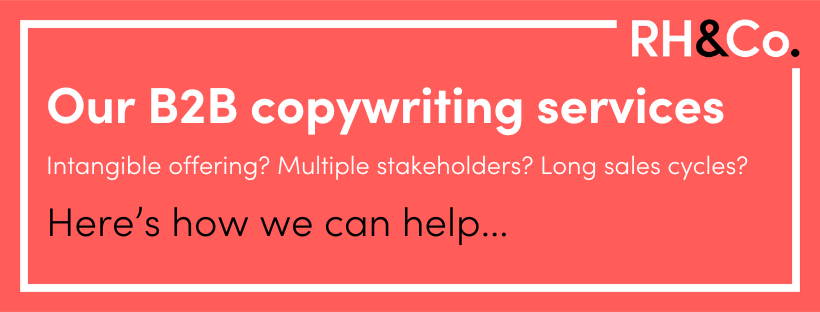
Hurdle 03: Getting buy-in from other stakeholders
Solution: ‘Leave behind’ content that sells on your behalf
It’s so frustrating. You’ve had a few great conversations with your primary contact. You’ve walked them through a demo or given them a great pitch – and they’re bought in. But now they have to get sign-off.
All too often in a B2B setting, we’re marketing or selling to more than one stakeholder. That requires us to adjust and adapt our messaging to different audiences with different priorities. And it often requires us to rely on someone else doing an internal sales pitch on our behalf.
Rather than leaving them to their own devices (are they really going to do it justice?), use ‘leave behind’ content to help them make your case as well as you would. This might be a pitch deck – one designed to be read, rather than viewed as part of a live presentation – a brochure, or any other piece of content that captures your core messaging and value proposition for that audience.
Hurdle 04: Following up a proposal without nagging
Solution: Content that facilitates easy decision-making
You’ve done all you can – now it’s time to wait for the go ahead or the “Sorry, we’ve gone in a different direction” email. Naturally, you’ll have tried to book in a follow up meeting but that isn’t always possible. Sometimes you just have to be patient.
Except, how long do you leave it? At some point, you’ll want to give your prospect a little nudge to see how things are going. But no one’s opening an email with the subject “Just following up…”, right?
To avoid that slightly desperate sense of nagging, think about how you can use follow up content to continue adding value. That might be a breakdown of how your costing works, a customer case study, or a “here’s what to expect if you go ahead” pre-onboarding guide. Anything that speaks to any doubts, queries or concerns they might be having in the decision-making process.
Hurdle 05: Your lead has raised an objection
Solution: Objection busting content that works throughout sales cycles
At some point during a long sales process, someone is going to raise an objection. If you’ve been in the game for a while, you’ll probably be able to list several common objections off the top of your head.
If these objections are raised in a face-to-face meeting, you should be prepared with a suitable answer. But why not preempt objections and use content to get ahead of your audience and provide even more value by helping them move past these blocks without having to voice them?
This type of content is especially important when the objection is coming from someone you don’t have access to yet, as in the case of getting buy-in from internal stakeholders, above. Here, the particular type of leave behind content you want is objective busting content.
As an example, we have an article on our blog titled ‘How can you blog for my business if you’re not an expert in my subject?’ We created it as a direct response to a challenge many in-house marketers face, which is getting their subject matter experts to accept that an outside agency could possibly create complex copy on their behalf.
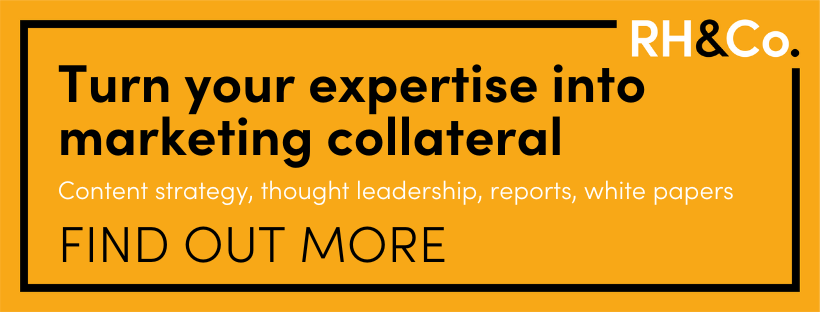
Bonus tip: Remember that B2B buyer research starts before they even get in touch
While your prospect’s first touchpoint with your organisation might be a proactive cold outreach over email or via social media, or a meeting at an event like a conference or exhibition, it may also be via a referral, a Google search, a media appearance or a post on social media.
According to research from Showpad, B2B customers spend an average of 20 hours researching a company, product or solution before they get in touch with a sales rep – and up to 40 hours if they’re planning on spending more than $100k. Which means you need to make sure there’s great content available to them wherever they look.
We’re talking everything from top of funnel content like white papers and infographics to more bottom of funnel content like technical specs and case studies.
Now you might be thinking, “That’s a job for the marketing department” – and you’re right, to a point. But why leave them in a silo? We’ve found that the clients who get the best results from their content are the ones who see the marketing and sales processes as deeply linked, and have departments that work collaboratively on content strategy.
You can read more about how we helped React Native specialist development agency Morrow use content to increase both the quantity and quality of their leads in this sales content case study. And if you’d like to talk content strategy with an agency that understands sales as well as marketing, get in touch with the RH&Co team today to see how we can support you.
The benefit of being a B2C marketer is that you’re normally marketing to individual people. OK, in some instances you might need to get your target buyer’s partner – or perhaps parent – to approve, but generally the final purchase decision is pretty much down to one or maybe two people.
In the B2B world, however, it’s much more complex, with all sorts of buyer personas needing to be convinced, each with a different agenda. So how do you go about building a marketing strategy that speaks to the right people at the right time?
That’s what we’re exploring in this, the second in our series on B2B marketing challenges. If you missed the first one – How to market an intangible offering – make sure you bookmark it for later. For now, let’s dig into the issue of multiple stakeholders.
TL:DR
- Know who comes in at what stage of the buyer journey
- Understand and cater for multiple needs
- Be consistent at every touch point
- Give your advocates a way to sell you in
Know who comes in at what stage of the buyer journey
The first thing you need to do – before you start creating your marketing plan – is to work out which individuals and departments come into the buyer journey at which stages. This will depend on a host of factors, from the size and complexity of the businesses you’re selling to, to how expensive, complex or business critical the product or service you’re selling is.
Whatever the case, there are some general principles that apply across most medium to large businesses…
In our research report, ‘What do CxOs read?’, we learned that C-level execs aren’t really in the market to be sold to. They’re operating at a far higher level than that – interested in the big picture and what’s coming over the horizon rather than which employee benefits platform or renewable energy supplier to choose.
Does that mean you shouldn’t market to them? Absolutely not. But see them for what they are – the agenda setters. They’re the ones that will put employee engagement or carbon neutrality on the radar. In that sense, they’re step one in the marketing long-game.
Later, layers of people below them will be tasked with digging into solution options and selecting potential suppliers or partners. Chances are that the first involved will be those whose department is most closely involved – say, the HR department, if we’re talking employee benefits.
Once you’ve got their attention, you’ll most likely need some sort of approval from other departments, possibly including Finance, IT or Procurement depending on the size of the organisation. In these final stages, the CxOs may well pop back up to give their seal of approval.
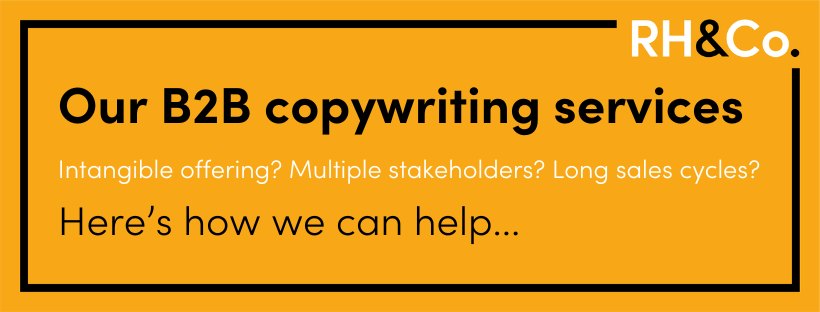
Understand and cater for multiple needs
Knowing which individuals and departments come in at which stage will help you build an appropriate funnel, and pitch the right ideas at the right time. Because each of your stakeholders will need something different from your marketing.
We’ve already talked about how CxOs are the agenda setters, the big picture thinkers, the horizon scanners. As such, they’re interested in learning about upcoming trends and being told what questions they should be asking in the boardroom.
Thought leadership, original research and trend roundups are all going to be useful here – the valuable, relational, educational content that doesn’t have even a whiff of sales about it.
Further down the line, the people tasked with solving a given problem will be looking to have that problem clarified for them, and the solutions explored. They still want impartiality at this stage, but you can move them towards more sales led content.
If you have to get through Procurement, they’ll be interested in compliance checks and making sure you tick all of their predetermined boxes. If what you’re selling falls outside of a department’s budget, you’ll be dealing with Finance, who will inevitably want numbers – what you charge, what results you’ll generate. IT, meanwhile, will want to understand how much you’ll be involved in technical implementation and how you’ll operationalise deployment.
Any comms or content at these levels need to be factual, detailed and as devoid of fluff as it is possible to get – while still maintaining your brand message and voice.
Be consistent at every touch point
Having said that you need to cater for each stakeholder’s individual priorities, it’s important that you don’t present a fractured image to your audience. Each touchpoint with your brand needs to have a degree of consistency, so that a) the HR department and the IT team don’t feel like they’re engaging with two different suppliers and b) a LinkedIn post and an outreach email still feel like they’re coming from the same brand.
To get this right, you need two things. First, you need a strong brand in the first place. You need to know your value proposition and your messaging, you need a distinct voice, and you need guidelines that ensure everyone sticks to them – from the team responsible for creating your thought leadership to the sales people sliding into people’s DMs on LinkedIn.
Second, you need a strategy that ties everything together. Your customer journeys and how people and departments fit into them. What your marketing department is creating and sharing and what your sales teams are following up with once they have a lead. All of these elements need to be tied together so that there’s a plan rather than a scattergun approach.

Give your advocates a way to sell you in
One of the biggest problems with having multiple stakeholders is that you don’t always have access to all of them directly or at least not at the same time. That means even if you gain one person’s attention, you might have to rely on them to accurately sell you in to someone else within the business before you have a chance to reach them yourself.
In a marketing setting, you can counter this with dedicated content that supports cross-stakeholder communications. Our employee benefits platform provider, to go back to that example, might put together an article on ‘5 things your CFO wants to know about our employee benefits platform’. Likewise, we’ve got a blog post about the business benefits of blogging and how to sell them to your boss.
In a face-to-face setting, you’ll need to think about the ‘leave behind’. If you’ve done a great job of pitching your product or service – or even a higher level idea, if you’re chatting to a C-level exec – you want to make sure what you’ve said doesn’t get lost in translation. This is where brochures, pitch decks, and other forms on content can be very powerful.
If you need support creating a content strategy that takes into account multiple stakeholders, get in touch today to see how we can help, or visit our content strategy service page to find out more about what we offer.
Do you ever wish you sold shoes? Or that you were responsible for marketing a 5 star hotel? Something nice and tangible, with a consumer audience and a pretty well defined value hierarchy.
Inevitably it gets much harder when you’re selling a B2B service with as many permutations as leadership development, or as hard to define as ESG consulting. Or maybe you sell something that’s concrete at face value – like offshore wind engineering – but it’s hard to define what makes you different to that other engineering company with a more established reputation.
For the marketers and salespeople tasked with generating and closing leads in these sorts of businesses, there are so many more hurdles to jump through. In our new series, we’re exploring three of those challenges and how best to tackle them. Today we’re starting with one that is literally the most difficult to describe: intangibility.
TL:DR
- Levels of intangibility in B2B businesses
- The real reason intangibility is a problem
- Solution 01: Make intangible elements more tangible
- Solution 02: Focus on measurable benefits and outcomes
- Solution 03: Build trust in your brand
Levels of intangibility in B2B businesses
The dictionary definition of intangible is “impossible to touch, to describe exactly, or to give an exact value.” For B2B businesses it’s the latter two points that cause the biggest challenge. And there are nuances to intangibility too.
For some businesses, their service itself is intangible. This applies to many consultants where what they’re really offering is thinking, conversation and recommendations. In many cases their offering will be entirely bespoke and therefore hard to describe or give a value to.
For others, the intangible element of their offering is the very thing that they hope will differentiate them. One of our clients is a contract cleaning company. They’ve built their business around a unique set of processes that make their service far superior to their competitors. But making that differentiation clear so companies will choose this company over cheaper suppliers is a constant challenge.
And then there are intangible outcomes. If you can demonstrate how you’ll be able to save a business £x each month, you have a relatively tangible benefit to offer. But where proof of success can’t be boiled down to a simple metric, it’s far harder.
In essence, the challenge of intangibility is one of assigning and communicating value. Your client values the tangible, you want to communicate the value of the intangible.
The real reason intangibility is a problem
So why is having an intangible service, USP or outcome such a challenge? Because people want to know what they’re getting for their money. And if you can’t give them a tangible answer, they’ll start trying to anchor your offering to something that feels more tangible to them, something they can justify to procurement or the CFO.
This leads to a skewed focus. For example, they might focus on deliverables when it’s the thought process behind those deliverables that actually adds the most value. Or they might focus on tangible results, which aren’t always easy to define or can be misleading, as is the case with vanity metrics.
Another wrong focus is time input, where clients want to understand the number of days being dedicated to a given project, which is a crude way of measuring value, especially in knowledge-based and creative sectors.
That client discomfort with the intangible might lead them to want to engage with you on a test project first. But in some cases this isn’t really practical. You can’t offer a company just a bit of data science, or a single element of a cultural transformation – and any alternative services you offer as an on-ramp are rarely representative of your core offering.
In essence, the challenge of intangibility is one of assigning and communicating value. Your client values the tangible, you want to communicate the value of the intangible. So how can you overcome this?
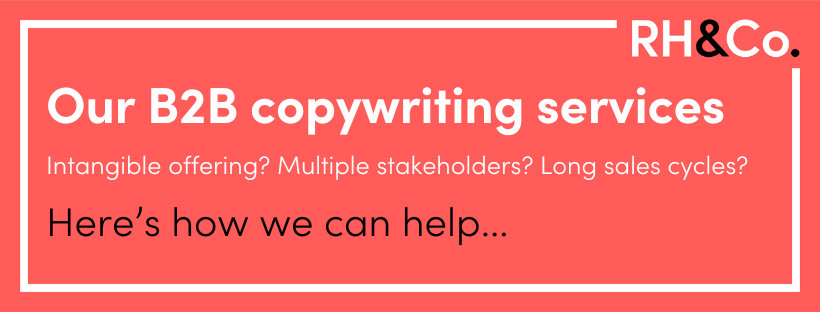
Solution 01: Make intangible elements more tangible
The first option is to ease their discomfort by making your intangible offering feel more tangible. This can be as simple as turning your unique process into a framework, or at least giving it clearly defined – and cleverly named, if you can stretch to it – steps.
For instance, although their IT transformation projects can take many forms, our client LXS Consulting breaks down their alt-net solutions into components, describing the value of each:
- Stakeholder management
- Pain point analysis.
- Business process engineering.
- Solution design.
- Architectural expertise.
- Business operations integration.
- Technology implementation.
- Testing.
Within our content strategy offering, we have a series of components such as Expert Gold Mining, Sales Enablement and Embedded Research, which help clients to understand what their strategy package will entail.
Likewise, a leadership development consultancy might talk about 360 reviews, employee engagements surveys or team coaching sessions.
By focusing on the ‘how’ of what you do – in other words, the features of your service – you sidestep the risk of being ‘fluffy’, which can sometimes happen when you focus purely on benefits, such as ‘empower your people to do more’.
But there is a danger too. Go too far down the features route and you risk productising your offering to the point where it becomes a commodity. From there it’s just a race to the bottom in terms of price.
Solution 02: Focus on measurable benefits and outcomes
So if too heavy a focus on features is problematic, then we need to make sure that’s balanced with good old benefits. The challenge is that here again intangibility rears its hard-to-define head.
You may think that the benefits you offer are tangible – saving your client time or money, for example, or boosting business performance. But if you leave it at that, you’re going to come across as fluffy. For your benefits to really feel tangible, you need to focus on measurability.
We worked with one client who could demonstrate how they helped small restaurant owners save an average of two days of invoicing admin each month, which is incredibly powerful.
But it’s not always that clear. For example, an employee engagement consultancy, you might be able to measure employee engagement to some degree or another. But it’s far harder to link that relatively intangible benefit directly to a tangible bottom line result.
Or what about where there are multiple partners contributing to a project? This might be the case with a new website launch, where the client engages a branding agency, a content agency, a development agency, even a UX or user testing agency. Which of these can claim to have offered the most value, since the final result is down to the combination of their skills?
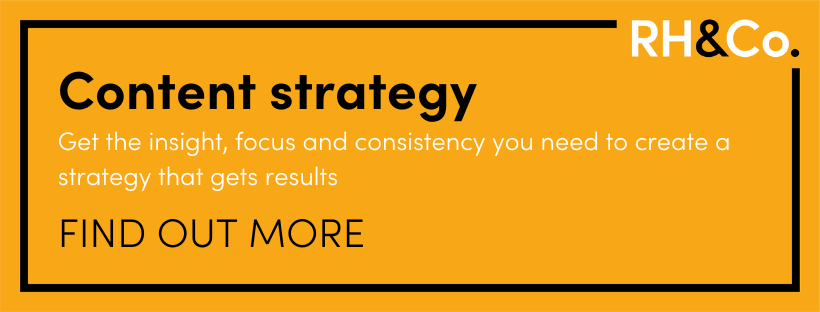
A side note on subjective vs objective value
We’ve already said that the problem of intangibility is really a problem of defining and communicating value. So part of overcoming the communications challenge around marketing or selling an intangible offering is about really understanding what your audience values.
In their HBR article, The B2B Elements of Value, authors Eric Almquist, Jamie Cleghorn and Lori Sherer, of global management consulting firm Bain & Company, describe the Elements of Value Pyramid. The pyramid encompasses 40 different types of value perceived by B2B buyers, organising them into five levels.
- At the base, you have Table Stakes, the basic criteria you’ll need to hit to even be considered. This includes elements like meeting specifications and acceptable price.
- Next is Functional Value, which can be economic (e.g. cost reduction or improved top line) or performance based (e.g. quality, scalability).
- Then there’s Ease of Doing Business Value, which covers a lot, from productivity (e.g. time savings, reduced effort) to relationship (e.g. expertise, cultural fit)
- On the next step up we find Individual Value – the value you offer to the person making the decision – both personal (e.g. fun and perks, reduced anxiety) and career (e.g. reputational assurance).
- And finally there’s Inspirational Value – this is where concepts such as vision and social responsibility come into play.
What’s interesting about the pyramid is the way that the more intangible or subjective value elements are closer to the top, while the foundation is made up of more tangible or objective ones.
This shows us several things about communicating the value of B2B offerings. First, we need to be able to tick the tangible, objective value boxes in order to be in the game. But we also need to be able to communicate value higher up the pyramid in order to differentiate ourselves.
Solution 03: Build trust in your brand
There is one final solution that, if you can achieve it, will outperform all the others, and that’s building trust in your brand. Because once a client trusts a brand, they’re far less likely to quibble over how many hours a consultant dedicates to a given programme or whether they’ll be able to measure the impact of a digital transformation programme.
After all, you don’t see clients asking McKinsey or Accenture to justify their prices or explain their consulting process in minute detail, businesses just assume that they will gain value because there is such deep trust in those brands.
Although building trust is far too big a topic to dive into in much detail here, there are two elements to consider: demonstrating (rather than describing) your worth, and having others validate that worth.
To demonstrate your worth, you need to put all that intangible knowledge into a tangible format that your audience can consume. From research reports to thought leadership articles, webinars to podcast interviews, expertise-based content gives your audience a way to ‘test’ your expertise without committing to engaging your services.
To have others validate your worth, call on the people who have already been convinced of your value. Get testimonials or, better yet, create case studies. Use NPS scoring or online review tools. PR is another important part of the puzzle here – a mention in a respected industry publication may be exactly what you need to get an introduction to the right person.
For more on how brand translates to value in the mind of your audience, check out our articles on what is brand, how brand influences investors, and how buyers perceive expertise.
B Corp certification is on the rise. There are now 2,000 B Corps in the UK, and over 8,700 in the world – and in March 2023, we were proud to become one of them.
We believe in business as unusual and we are on a mission to not only uphold B Corp’s high standards of social and environmental performance, transparency and accountability ourselves, but encourage others to do the same.
If you want to know how to become a B Corp, here’s a deep dive into everything we’ve learned along the way.
TL:DR
- Why become a B Corp?
- What does becoming a B Corp involve?
– The B Impact Assessment
– Gathering evidence
– Submission and membership fees
– How long does certification take? - Tip 01: Get buy-in from your team
- Tip 02: Find a system and stick to it
- Tip 03: Use tech to make tracking and reporting easier
- Tip 04: There’s no need to go it alone
- Tip 05: Remember, becoming a B Corp is not a one-off process
- More information and how to get started
Why become a B Corp?
There’s no getting around the fact that B Corp certification does take a lot of time and effort – as it should do. So before you start out on the process, it’s good to remind yourself about why you want to do it.
Naturally one key reason will be validating the efforts you’re already making as a values-led business. The process will also give you a framework for increasing those efforts and having an even greater impact on people and the planet.
“The benchmarking aspect was a real driver for me,” says RH&Co founder Rin. “I wanted to know what good looks like, so we can aim for that in all we do as a business. Understanding where we’ve got gaps, where we’re not doing as well as we could, is the best way to challenge ourselves to be better this year than we were last year.”
And there are harder business benefits too. According to the latest stats, between 2017 and 2020 B Corps saw average turnover growth of 26% compared to the national average of 5%, and between 2018 and 2021 B Corps saw an average employee headcount growth of 14% compared to the national average of 1%. All useful to know if you need to get buy-in from any of your more commercially focused colleagues.
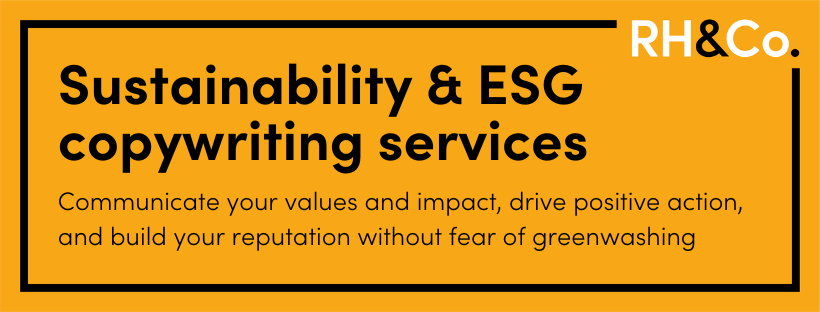
What does becoming a B Corp involve?
Now let’s look at the process. In a nutshell, there are three main steps:
- Complete the B Impact Assessment to get your initial score
- Create and collate the evidence needed to back up your assertions
- Go through the review process and receive your final score
As part of the assessment and evidence process, you’ll need to change your company’s articles of association in order to build your commitment to people and planet into your legal structure, protecting it now and in the future.
The B Impact Assessment
The assessment is made up of around 200 questions that cover 12 months of operations across five key impact areas: governance, environment, customers, community and workforce. You’ll be asked everything from how you track customer satisfaction to what the ratio is between the highest and lowest salaries in your organisation.
You’ll need to get over 80 points to certify and you’ll need to recertify every three years, during which time the standards are likely to go up – so you can’t just rest on your laurels.
Gathering evidence
This is where the real work comes in. In general, you’ll find yourself needing to do three things:
- Documenting what’s already happening e.g. we’ve always supported charities in various ways but now we have a policy that sets out formal schemes including volunteer days and match funding for any money team members raise.
- Measuring what’s already happening e.g. we’ve always tried to use local suppliers where we can but now we are tracking the proportion of our purchases that are made through local suppliers and have a target for increasing that number.
- Implementing new ideas that aren’t yet happening e.g. we started a cycle to work scheme because going through the assessment made us look at the options currently available to the team in terms of travelling to work.
Submission and membership fees
You’ll need to pay a £250 fee when you submit your application to show that you’re committed to the verification process. Then once you’ve certified, you’ll need to pay an annual membership fee, which is weighted depending on your revenue, starting at £1,000 for business turning over less than £150,000 per year and going up to £50,000 for those turning over £750m to £1bn.
How long does certification take?
Realistically, you should expect the entire process to take up to a year. We started in March 2022. It took us three months to complete the B Impact Assessment and gather enough evidence to feel confident that we would reach the required score.
We were then in a queue for our review for 9 months, during which time we continued to work on evidence gathering. Around 4-6 weeks before our interview, our verification analyst began asking for additional pieces of evidence, and then the interview itself took around half an hour. We heard back on our final score within a few days.
Tip 01: Get buy-in from your team
While you’ll need one person or team to take ownership of the project, B Corp certification is a whole-business effort. Everyone has a part to play, whether that be your IT or procurement lead choosing to buy reconditioned tech from a local supplier, or the finance department processing supplier invoices in good time, or HR ensuring that their recruitment policy encourages diversity.
There’s no point having a cycle to work scheme in place if no one uses it, or having recycling bins if everyone prints more documents than they actually need to. Remember, being a B Corp is about more than window dressing. Your values have to be lived not just written down on the About page of your website. If you haven’t got a B Corp culture, you’re really going to struggle to get the certification, and rightly so.
“I had no idea what B Corp was all about before we started our application process but going through the certification process really opened up my eyes to how important it is,” says RH&Co Sales & Marketing Assistant Ingrid Morgan.
“In a world where so many companies are doing business the wrong way – treating employees unfairly, damaging the environment, putting profit above anything else – I’m proud to be working for an organisation that is taking a stand and doing things the right way.”
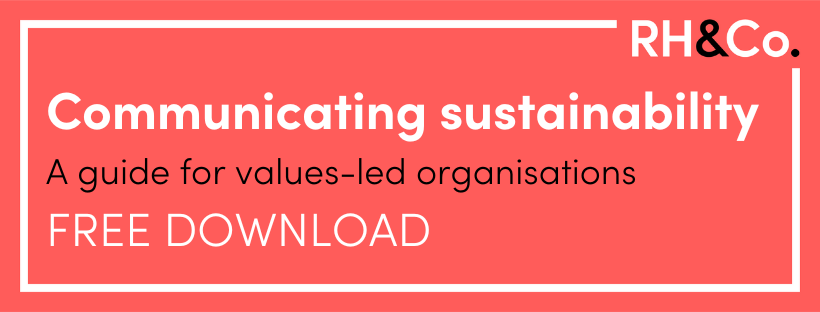
Tip 02: Find a system and stick to it
B Corp certification is largely an evidence-based process. You can’t just answer the questions, you have to back those answers up. And remember, there are 200 of them. That’s 200 process documents, evidence logs, survey summaries and more.
As a result, it’s important to create a system that works for you so that you can track what’s been done, what still needs to be done, who is doing what, where relevant files are and so on.
“You do need to be organised,” says Liz Leaman, RH&Co’s Operations Director and our lead on the B Corp project. “Make sure you break things down into bite sized chunks. Set yourself a section to do every week and just keep plugging away at it, bit by bit. It might take you months but that’s ok.”
Tip 03: Use tech to make tracking and reporting easier
B Corp certification involves gathering and monitoring a lot of data. For some tasks, a good old spreadsheet might be enough but there is plenty of tech out there designed to make it easier to monitor your sustainability journey.
For example, we’ve been using Giki Zero to track our personal carbon footprints. Each of us has a Giki profile where we’ve answered a series of questions about our habits ranging from the type of transport we use to the type of food we eat. This initial setup gives us our individual carbon footprint. From there we can try out ‘steps’ – categorised by type and impact size – to improve our score, whether that be something as simple as using the eco setting on the washing machine or as complex as installing solar panels.
RH&Co copywriter James Matthews says: “I was pretty nervous about tracking my carbon footprint at first, since I don’t have the option to make a major change like replacing my boiler or installing a heat pump. But Giki is great at giving practical suggestions everyone can take, like unsubscribing from junk mailing lists. Once you start taking small actions and seeing your score change, you start wondering if there are bigger steps you can take after all.”
Tip 04: There’s no need to go it alone
If there’s one thing B Corp does well, it’s community. So why not get into the habit of working together during the certification process? You’ll find most B Corps are very willing to answer questions and share advice, and there are also specially trained B Leaders who have been equipped with the tools and knowledge needed to support businesses on their B Corp journey.
We worked with Andy Hawkins of Business On Purpose, who runs small group cohorts on a regular basis. Getting involved in these sessions not only helped us to understand the assessment process and gave us a chance to ask questions when we weren’t clear, it also allowed us to share that journey with others in a similar circumstance and learn from their experiences.
“I really enjoyed our sessions with Andy and the rest of the businesses who were going for their B Corp certification,” says RH&Co’s Project Administrator, Kassi Marshall, who supported Liz on our B Corp project. “It kept us motivated and accountable, and it was good to feel like we were part of something bigger.”
Tip 05: Remember, becoming a B Corp is not a one-off process
If you’re thinking that B Corp certification is a quick win marketing exercise, think again. Sure, earning the right to put the B Corp logo next to yours will most likely win you points in the eyes of a values-driven audience – but if that’s the main goal then you’re unlikely to get far.
B Corp certification tests your mettle in a way that goes well beyond the surface. You can’t just appear to be doing good, you actually have to prove it. As an example, we’ve always recycled in the office. But that wasn’t enough. First, we had to submit a photo of our recycling bins to prove we’re doing what we say. And we now also track how much rubbish goes into each bin – landfill vs recycling – and have targets to reduce the landfill amount.
Rin says, “For us certification was just the first step. The real goal of being a B Corp is to keep making progress, as well as encouraging others to do the same.”
More information and how to get started
B Corp has a huge number of resources available to help you through every step of your certification process but we’ve found that sometimes so much information can be overwhelming! There are also a number of microsites, which adds to the confusion.
So here are some of the key pages you’ll need to get started:
If you still feel that B Corp certification is for you and your business, we wish you the very best on your journey. It’s an awesome community and an enormously worthwhile step in your sustainability journey. If you’ve got any questions about our experience of the process, please don’t hesitate to get in touch.
If you’re a marketer responsible for executing an expertise-based positioning strategy, you’ll know how important it is to collaborate with the subject matter experts in your business to create expertise-based content. But how exactly do you go about doing that?
Before you start, you might want to take a look at the first two articles in our series on communicating expertise:
- Expertise: what it is and how buyers perceive it
- How to build brand authority using expertise-based content
Now you’re all caught up, it’s time to focus on the particular challenges you’re likely to face as you go about creating expertise-based content to support your brand position.
While you may be well versed in your industry – even a specialist – you’re not the subject matter expert. The person or people with the deepest insights might be the founder or CEO, the CTO or Chief Science Officer, the product team or the consultants out in the field.
As we mentioned in the second article, content produced by marketers in isolation from subject matter experts is likely to feel insubstantial, no different from that created by businesses with no expertise full stop. To set your content apart and make your brand’s reputation shine, you’re going to need to work with your experts.
Easier said than done. Here are some of the challenges that you’re likely to face, along with solutions you can use to ensure you get the most out of them.
TL:DR
- Challenge 01: Your subject matter experts aren’t marketers
- Challenge 02: Your experts are very busy people
- Challenge 03: They just have too much expertise and knowledge
- Challenge 04: They don’t know how expert they are
- Challenge 05: They just don’t respect your position
- A bonus challenge and solution
Challenge 01: Your subject matter experts aren’t marketers
Every content marketer dreams of finding a subject matter expert who is also a brilliant content creator. Few realise that dream. It’s rare that a leading data scientist or pioneering microbiologist or highly qualified leadership consultant is also a talented and experienced marketer.
Chances are, if left to their own devices, your subject matter experts will pitch their writing at the wrong level for your audience. They will almost certainly use the wrong tone of voice – especially if they come from an academic background. And it probably won’t be strategically informed.
Solution:
This is where you bring together their expertise and yours. Even if you’re lucky and your experts are fairly decent writers, you’ll still need to create the content strategy, set the topic areas, write decent briefs, make sure there are thorough brand voice guidelines available, and probably do a lot of editing.
But that may not be enough. If your experts aren’t likely to be able to craft great content even with guidance, you’ll need to think of them as gold mines. Your job is to dig until you find a rich seam and then extract as much gold as possible and use it to craft the content yourself.
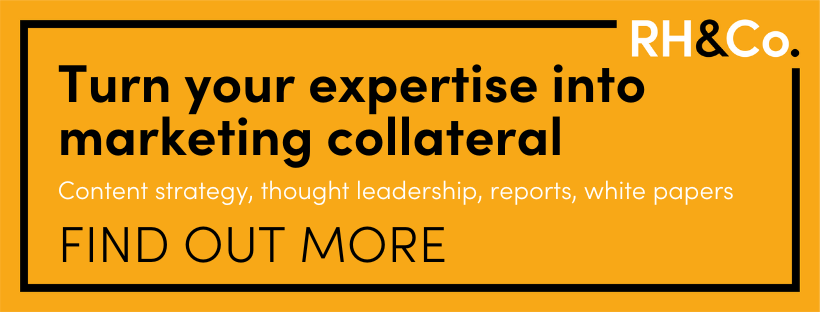
Challenge 02: Your experts are very busy people
Even if you’ve landed yourself an expert who is adept at creating content, there’s a good chance they’ll be too busy to put pen to paper. At least not with the frequency and consistency you need to support a decent content strategy.
It could also be that they simply aren’t all that interested, especially if they can’t see the benefit of creating expert content. Which means even if they say yes, they’ll find some reason why they couldn’t deliver this month – sorry, too much going on with the latest sprint or patent application or fundraising round.
Solution:
Let’s address the latter issue first. If your expert isn’t convinced that content is important, you’re going to need to sell the benefits and make your case. Remember, they’re not the marketing expert, you are – it might be obvious to you that expertise-based content can have a significant impact on the business but not to them. Find out what it is they care most about – whether it’s generating leads or getting speaking engagements – and appeal to that.
Then, once they’re convinced, make it easy for them. Rather than bugging them every week, arrange a longer session once a month or even once a quarter to get the information you need for a content series.
And make sure that you do your research so that rather than asking them the basic questions – the stuff you could find out with a bit of research – you can ask them for those insights that only they as experts can bring: the anecdotes, the opinions, the nuance.
Challenge 03: They just have too much expertise and knowledge
Experts, by their very nature, hold a lot of information in their heads. They may be good at accessing that information, but they’re probably less adept at sifting through it and working out which bits are relevant to the given piece of content you’re creating. Being passionately interested in their subjects, they may well go into far too much detail.
Solution:
Imagine that information is a tangle of yarn. In that state, it isn’t inherently useful unless you’re a passionate collector of yarn. In order for it to be useful, it needs to be untangled, and the right strands knitted together according to a pattern to form that jumper, or a scarf or a hat. Ditto information.
As a marketer responsible for creating content based around subject matter expertise, you need to get good at extracting the right information from your experts – the untangling and selecting process – as well as using it to create the content itself. So you’ll need to learn to ask the right questions and guide the conversation so it stays on the right track, pushing back when your expert veers off track.
It might also be helpful to create a brief for your experts to consider in advance so they feel prepared. This is especially important if your expert is prone to rambling or if they’re the kind of person who likes to ponder a question for a few minutes – or hours – before giving their answer.
You’ll know – or get to know – your own experts and what you need to do to get the best out of them.
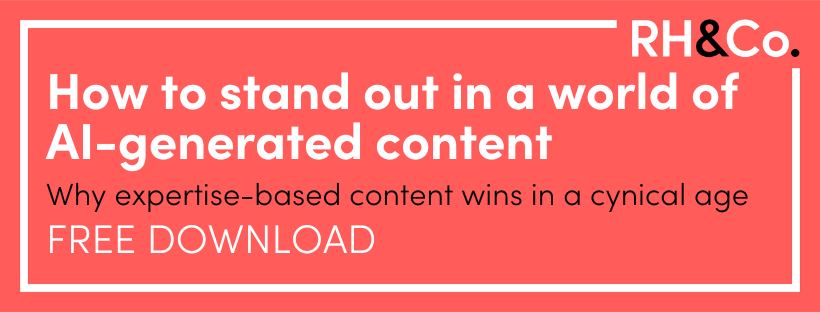
Challenge 04: They don’t know how expert they are
If challenge 03 is about your expert sharing too much detail, this one is the opposite. Experts often sit at the last of the four stages of competence – unconscious competence. That’s when you’re so good at something, or so knowledgeable about something, that you don’t realise how much others don’t know.
This can lead to two different problems. In the context of creating content, your expert may not drill down into a subject in enough detail because they assume you – or your brand’s audience – understand their jumping in point. Or they might completely miss the most interesting and relevant points full stop because again, to them it’s ordinary even though you know that your audience would be fascinated.
Solution:
Again, your job here is to help your experts to a) identify what’s interesting to their audience and b) pitch it at the right level.
In our briefing sessions at RH&Co we often help experts to come up with analogies to make whatever it is they’re talking about more understandable to the brand’s audience. As an example, we work with a company that’s in embedded finance and one of their experts was talking about the difficulty of performing KYC (Know Your Customer) checks to protect against financial crime. The analogy we helped them come up with was:
“It’s the equivalent of taking a utility bill to the bank to prove identification. Except in this case, the bills aren’t yours and you might not know how to find the people who have them.”
You can see how that instantly makes the subject a lot more tangible and relatable.
Challenge 05: They just don’t respect your position
This one might sound a little harsh but we’ve heard it from enough marketers to know that it’s true, even if it’s not meant as badly as it sounds when you write it down in black and white. It’s just so much easier to cancel an internal meeting than an external one, or push team based tasks down the to-do list because a request related to a client project feels more urgent.
Solution:
In the same way that kids will often ignore their parents but listen as soon as a visitor has something to say, we’ve found that experts usually pay better attention to us as outsiders than they do to their own people.
Another benefit of being an outsider is that we can push back without fear of internal politics. We’ve often stayed on a briefing call with a marketer after the subject matter expert has left and heard them marvel at how much we’ve managed to extract. They may have been asking the same questions for weeks and not getting anywhere. It’s annoying but it’s just the way it is with some experts.
A bonus challenge and solution
If you’re considering bringing in support to help you extract the right information from your subject matter experts and use it to create genuinely useful, authority-building content, you may find yourselves facing one final hurdle.
The problem with some subject matter experts is that they don’t believe anyone else is capable of representing their knowledge faithfully. That’s why we wrote “How can you blog for my business if you’re not an expert in my subject?” Follow the link for a post that’s designed precisely to help you make your case without treading on any political landmines.
And if you’d like to talk more about building your brand authority using expertise-based content, get in touch.

